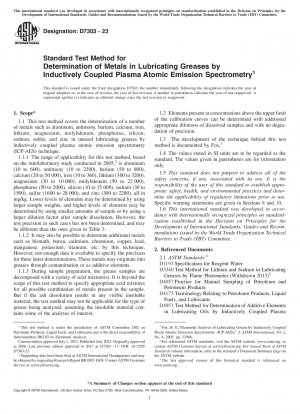ASTM D7303-23
Standard Test Method for Determination of Metals in Lubricating Greases by Inductively Coupled Plasma Atomic Emission Spectrometry
- Standard No.
- ASTM D7303-23
- Release Date
- 2023
- Published By
- American Society for Testing and Materials (ASTM)
- Latest
- ASTM D7303-23
- Scope
- 1.1 This test method covers the determination of a number of metals such as aluminum, antimony, barium, calcium, iron, lithium, magnesium, molybdenum, phosphorus, silicon, sodium, sulfur, and zinc in unused lubricating greases by inductively coupled plasma atomic emission spectrometry (ICP-AES) technique. 1.1.1 The range of applicability for this test method, based on the interlaboratory study conducted in 2005,2 is aluminum (10 to 600), antimony (10 to 2300), barium (50 to 800), calcium (20 to 50 000), iron (10 to 360), lithium (300 to 3200), magnesium (30 to 10 000), molybdenum (50 to 22 000), phosphorus (50 to 2000), silicon (10 to 15 000), sodium (30 to 1500), sulfur (1600 to 28 000), and zinc (300 to 2200), all in mg/kg. Lower levels of elements may be determined by using larger sample weights, and higher levels of elements may be determined by using smaller amounts of sample or by using a larger dilution factor after sample dissolution. However, the test precision in such cases has not been determined, and may be different than the ones given in Table 3. 1.1.2 It may also be possible to determine additional metals such as bismuth, boron, cadmium, chromium, copper, lead, manganese, potassium, titanium, etc. by this technique. However, not enough data is available to specify the precision for these latter determinations. These metals may originate into greases through contamination or as additive elements. 1.1.3 During sample preparation, the grease samples are decomposed with a variety of acid mixture(s). It is beyond the scope of this test method to specify appropriate acid mixtures for all possible combination of metals present in the sample. But if the ash dissolution results in any visible insoluble material, the test method may not be applicable for the type of grease being analyzed, assuming the insoluble material contains some of the analytes of interest. 1.2 Elements present at concentrations above the upper limit of the calibration curves can be determined with additional appropriate dilutions of dissolved samples and with no degradation of precision. 1.3 The development of the technique behind this test method is documented by Fox.3 1.4 The values stated in SI units are to be regarded as the standard. The values given in parentheses are for information only. 1.5 This standard does not purport to address all of the safety concerns, if any, associated with its use. It is the responsibility of the user of this standard to establish appropriate safety, health, and environmental practices and determine the applicability of regulatory limitations prior to use. Specific warning statements are given in Sections 8 and 10. 1.6 This international standard was developed in accordance with internationally recognized principles on standardization established in the Decision on Principles for the Development of International Standards, Guides and Recommendations issued by the World Trade Organization Technical Barriers to Trade (TBT) Committee.
ASTM D7303-23 Referenced Document
- ASTM D1193 Standard Specification for Reagent Water
- ASTM D3340 Standard Test Method for Lithium and Sodium in Lubricating Greases by Flame Photometer
- ASTM D4057 Standard Practice for Manual Sampling of Petroleum and Petroleum Products
- ASTM D4175 Standard Terminology Relating to Petroleum Products, Liquid Fuels, and Lubricants
- ASTM D4951 Standard Test Method for Determination of Additive Elements in Lubricating Oils by Inductively Coupled Plasma Atomic Emission Spectrometry
- ASTM D5185 Standard Test Method for Determination of Additive Elements, Wear Metals, and Contaminants in Used Lubricating Oils and Determination of Selected Elements in Base Oils by Inductively Coupled Plasma Atomic Emission Spectrometry (ICP-AES)
- ASTM D6299 Standard Practice for Applying Statistical Quality Assurance and Control Charting Techniques to Evaluate Analytical Measurement System Performance
- ASTM D6792 Standard Practice for Quality Management Systems in Petroleum Products, Liquid Fuels, and Lubricants Testing Laboratories*, 2023-11-01 Update
- ASTM D7260 Standard Practice for Optimization, Calibration, and Validation of Inductively Coupled Plasma-Atomic Emission Spectrometry (ICP-AES) for Elemental Analysis of Petroleum Products and Lubricants
ASTM D7303-23 history
- 2023 ASTM D7303-23 Standard Test Method for Determination of Metals in Lubricating Greases by Inductively Coupled Plasma Atomic Emission Spectrometry
- 2017 ASTM D7303-17 Standard Test Method for Determination of Metals in Lubricating Greases by Inductively Coupled Plasma Atomic Emission Spectrometry
- 2012 ASTM D7303-12 Standard Test Method for Determination of Metals in Lubricating Greases by Inductively Coupled Plasma Atomic Emission Spectrometry
- 2006 ASTM D7303-06 Standard Test Method for Determination of Metals in Lubricating Greases by Inductively Coupled Plasma Atomic Emission Spectrometry
